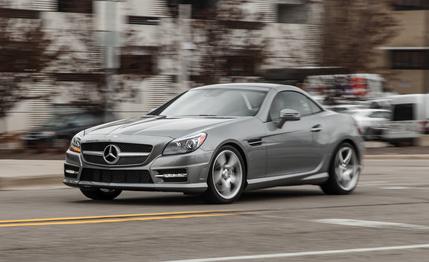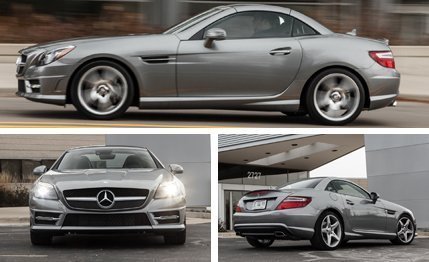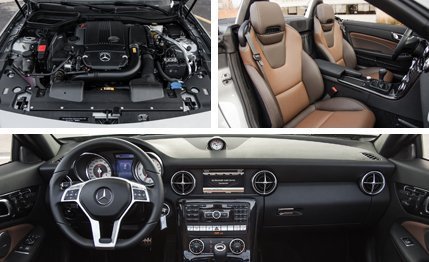 Instrumented Test
Instrumented Test
Care to shift for yourself but resolutely abstain from anything not built by Mercedes-Benz? Your choices, good eccentric sir, are excruciatingly limited. So limited, in fact, that the correct word is “choice,” not “choices.” The 2015 SLK250 is the only U.S.-market vehicle wearing the three-pointed star to offer a stick shift. Since buyers selecting the manual represent only a tiny percentage of SLK customers—themselves a tiny fraction of the buying populace, with just 4757 new SLKs sold in 2013 and 4353 moved in the first eleven months of 2014—this test was, for the most part, born from our sheer curiosity.
To put the SLK250’s position in the loneliest of light, it should be mentioned that not only is every other Mercedes-Benz sold in America automatic-only, but so, too, is the entire high-performance AMG lineup. We figure that Mercedes, considering the SLK’s overtly sporty competitors such as the Audi TT, the BMW Z4, and the Porsche Boxster, needs a manual to establish at least some sporting credentials.

The manual transmission certainly increases the SLK’s driver-engagement factor, and we appreciated the shifter’s tight throws and the clutch’s precise takeup. We’d christen the transmission a success were it not for the outdated engine it’s mated to. The 1.8-liter four-cylinder turbo’s boost is slow to build, making rev-matched downshifts tricky and lending the powertrain an air of sluggishness. We might be Savers of the Manuals, but this manual’s savior is a different engine. Subbing in the 2015 C-class’s turbocharged 2.0-liter four would be a good step in the right direction. (This may happen when the SLK is updated within a year or so, but we understand that the manual may be dropped at that time.)
It’s a shame about the engine, because the SLK’s chassis surprises and delights with a playful tail-happy attitude. Disable the stability control, vector the SLK’s nose into a tight corner while dabbing the brakes, and the back end whips around in a decisive, easily controlled manner. Our test car came equipped with the optional Dynamic Handling package ($990), which includes adaptive dampers with Sport and Comfort modes, as well as the Sport package ($2500), which brought 18-inch AMG wheels, a body kit, and red ambient cabin lighting.
Hampered slightly by axle hop off the line, the SLK nonetheless hit 60 mph in 6.3 seconds and circled our skidpad to the tune of 0.95 g. That zero-to-60 figure is 0.9-second off the 302-hp SLK350’s pace, but the skidpad result is stickier by 0.06 g. The SLK’s steering is perfectly weighted and effort builds smoothly as cornering forces increase, although nuanced road feel is left out of the equation. The brakes are reassuring in spite of a pedal that could be firmer, and the binders halt the little roadster from 70 mph in just 160 feet.

In more sedate scenarios, the SLK tries mightily to impersonate its SL-class sibling. It only partially succeeds. It might share much of its aesthetic with the SL—minus that car’s awkward detailing and odd proportions—but the SLK lacks a good measure of its bigger brother’s luxury vibe. A lot of road and tire noise penetrates the cabin, and the turbo four booms at highway speeds. Over chassis-twisting obstacles, the roof elements squeak and groan, but it should be noted that the lid’s generous glass area affords visibility unmatched by most other convertible tops. Our test car’s $2500 electrochromic “Magic Sky Control” fixed sunroof adds to the airy sensation, and it brings extra relief to the tight cockpit.
The small-but-upscale roadster segment is a shrinking one, but the SLK still stands near the top. At a starting price of $44,875, this Mercedes offers decent value, with power seats, Bluetooth, rain-sensing wipers, 17-inch wheels with summer tires, and the convertible hardtop standard. Slather on an additional $15,695 in options to get our test car, and it is a tougher pill to swallow, especially when the 10Best–awarded Porsche Boxster offers more flash and dash for similar money. There certainly is novelty in this SLK’s manual transmission, but we’d still have the quicker, V-6–powered SLK350 or the fire-breathing, eight-cylinder SLK55 AMG. How would one of those perform with a manual? It’s too bad we won’t ever find out.